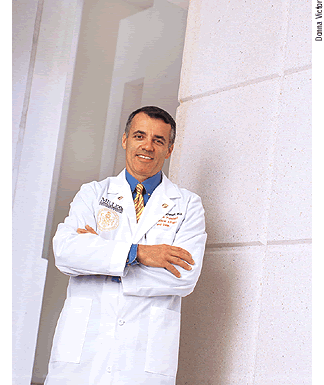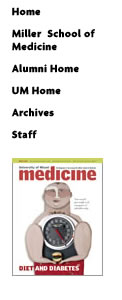 One concept that can rally all parents of South Florida is
that our children deserve the best medicine and health care
in the world. Today, many of the best health programs for children,
whether at the cutting edge of pediatric medicine or focused
on prevention and health promotion, are right here in our backyard.
The potential for academic and community hospital and health
care professionals to make Miami an even better place for kids
by collaborating and consolidating strengths is the first step
toward building one of the finest systems of child health care
in the world. One concept that can rally all parents of South Florida is
that our children deserve the best medicine and health care
in the world. Today, many of the best health programs for children,
whether at the cutting edge of pediatric medicine or focused
on prevention and health promotion, are right here in our backyard.
The potential for academic and community hospital and health
care professionals to make Miami an even better place for kids
by collaborating and consolidating strengths is the first step
toward building one of the finest systems of child health care
in the world.
As a parent, I wish that the barriers that
are created by competition between children’s hospitals—often associated with
a lack of communication of critical information—could
be knocked down. Each of the pediatric programs in South Florida
claims something that is the best. If these strengths could
be realigned so that a large system of care with many points
of access could be created, the possibility for all children
to receive the best and most cutting-edge health care can be
a reality.
By building these partnerships, Miami can
become renowned as one of the world’s centers for excellence in children’s
health care. We are close. We have champions among our nurses,
our doctors, and our staff who care for children, and we have
researchers who can advance the field of pediatric medicine.
Hospital leaders and physicians who once saw each other as
competitors are starting to consider how much better the access
to health care could be for children if we work together.
For more than a year, leaders from the Miller
School of Medicine and Jackson Memorial Hospital have been
meeting with leaders
of other South Florida hospitals to push the envelope— to
design a comprehensive system of the best care for children.
The group concluded that everyone benefits from this collaboration—the
pediatricians, the hospitals and, most importantly, the children
and their families.
Our central goal is to maximize access to
care for all South Florida children, no matter how common
or esoteric their problem
may be. We may find that the best model is to create complementary
centers of excellence in our various hospitals and arrange
seamless access to these centers, regardless of where the
child’s
primary health care is provided. Alternatively, we may find
a way to create a global affiliation, with new world-class
facilities that combine our strengths while building a network
of care in the communities where children live. Such a network
would immediately become one of the largest and best in the
world.
It is clear that integrated pediatric cancer,
heart, transplant, developmental, and community pediatrics
programs will result
in economies of scale, greater community and philanthropic
support, and better outcomes because we combine our strengths.
We may also be able to redistribute our resources so that
the more than 100,000 children in South Florida who have
no health
insurance can get the same level of care as those whose families
have jobs and resources that provide insured care. To make
this happen, we will have to learn how to avoid protecting
our turf, seeing instead the wealth of benefits that come
when we raise the level for everyone.
We have an opportunity to show South Florida
and other child health providers across the nation and even
the world how to
make this happen. Because we have the leaders, the vision,
and the dedication, the opportunities are limitless, the
risks are minimal, and access to health for all children
in the community
is finally attainable. Pascal J. Goldschmidt, M.D., is senior vice
president for medical affairs and dean of the Miller School
of Medicine. |
